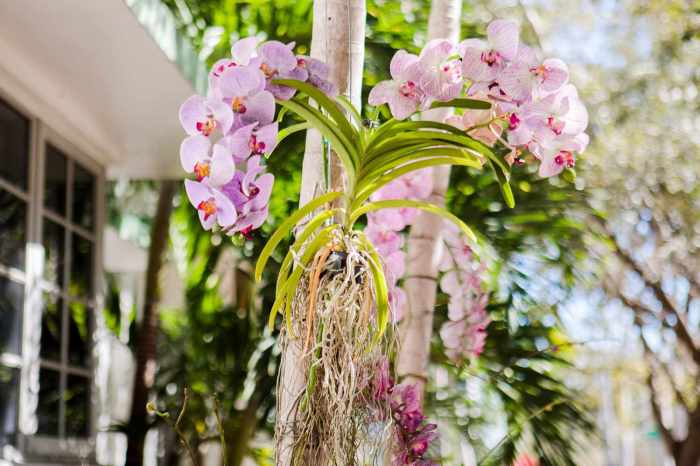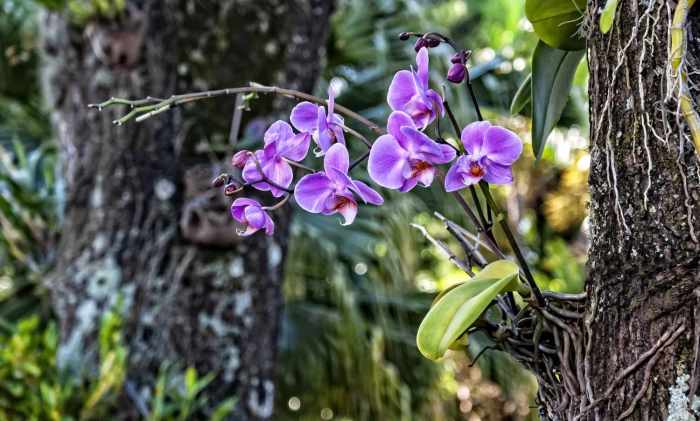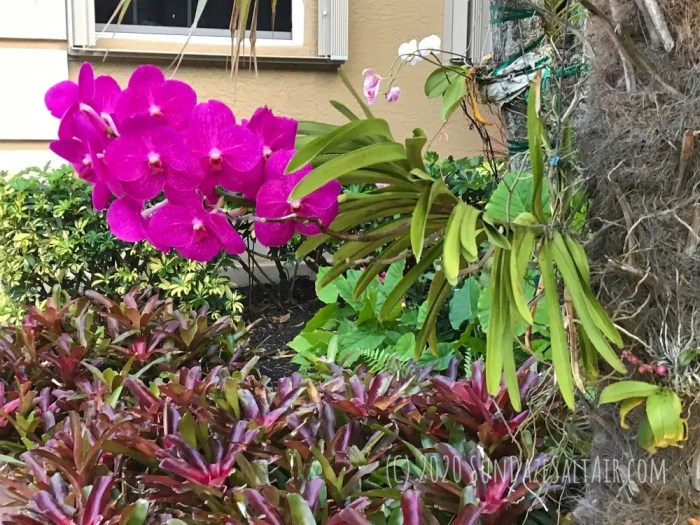Preparing the Orchid and Tree for Mounting: How To Plant Orchids In Trees

How to plant orchids in trees – Alright, plant-parent pals, let’s get this orchid party started! We’ve got the tree, we’ve got the orchid – now it’s time to get them ready for their epic, arboreal rendezvous. Think of this as prepping for a celebrity wedding; every detail counts!Preparing the orchid and the tree is crucial for a successful mount. Improper preparation can lead to orchid stress, slow growth, or even death.
So, let’s get this right, and give our orchids the VIP treatment they deserve.
Orchid Root Preparation
Before we even think about attaching our orchid diva to its new home, we need to give those roots some TLC. Think of this as a pre-wedding spa day for the orchid. Gently remove the orchid from its pot. Carefully loosen the potting medium from the roots. You’ll want to remove as much of the old potting medium as possible without damaging the roots.
Use a soft brush or your fingers to gently remove any stubborn bits. Inspect the roots. Trim away any dead, mushy, or decaying roots with a sharp, sterile pair of scissors or pruning shears. Healthy roots are firm and have a silvery-green color. Think of it like getting rid of those pesky split ends before a big night out! Once you’ve done this, rinse the roots gently under lukewarm water to remove any remaining debris.
This cleaning process ensures that the roots are healthy and ready to attach to the tree.
Tree Surface Preparation
Now, let’s get the tree ready for its glamorous guest. You’ll want to choose a section of the tree that receives dappled sunlight, rather than direct, intense sun. Too much sun can scorch the orchid’s delicate leaves. Also, make sure the bark is relatively smooth and free of loose pieces, cracks, or sharp edges that could damage the orchid roots.
If the bark is particularly rough, you can gently scrape away any loose pieces with a soft brush or a dull knife. Remember to avoid damaging the tree’s living tissue. A little light sanding might be necessary to create a smoother surface for better adhesion. Think of it like prepping a canvas for a masterpiece! After cleaning, allow the tree to dry completely before attaching the orchid.
This prevents the buildup of moisture and potential rot.
Attaching orchids to trees is a rewarding experience, requiring careful consideration of the host tree’s health and species. Choosing the right tree is key; for optimal orchid growth, research the best species to support their needs, perhaps consulting a guide like this one on best trees to plant in backyard to find suitable candidates. Remember to select a healthy, established tree and use appropriate mounting techniques to ensure your orchids thrive.
Orchid Mounting Methods
There are several ways to attach your orchid to its new tree-home. Each method has its own advantages and disadvantages, so choose the one that best suits your orchid and your style.
Using Organic Materials
Many people prefer using all-natural materials to attach their orchids. This method is environmentally friendly and generally gentler on the orchid. Common materials include sphagnum moss, coconut fiber, and fishing line or twine. You can use the moss or coconut fiber to create a small pad around the orchid’s roots, then secure it to the tree using the twine or fishing line.
Think of it as creating a comfy little nest for your orchid. This method is particularly good for orchids with many roots.
Using Wire
For a more secure attachment, you can use thin, coated wire, such as aluminum wire. Wrap the wire gently around the orchid’s roots and secure it to the tree. Be careful not to wrap the wire too tightly, as this could constrict the roots and prevent growth. This method is often preferred for larger orchids or those with fewer roots.
Remember to choose a wire that won’t rust or harm the orchid. It’s like giving your orchid a little hug, but with wire.
Mounting the Orchid on the Tree

Alright, so you’ve prepped your orchid and your tree – think of it like getting your bandmates ready before a killer gig. Now it’s time for the main event: mounting your orchid! This is where you get to unleash your inner horticultural rockstar. We’re talking about securing your orchid to its new home, making sure it’s comfy, secure, and ready to jam out some serious photosynthesis.
Orchid Mounting Methods Compared
Choosing the right mounting method is crucial. It’s like picking the perfect guitar – the wrong one and you’ll be struggling with sour notes all day long. Here’s a breakdown of your options:
| Method | Materials | Advantages | Disadvantages |
|---|---|---|---|
| Wire Mounting | Wire (galvanized or stainless steel), orchid mounting glue (optional) | Strong, secure hold; allows for easy adjustment; good air circulation. | Can potentially damage roots if not done carefully; requires some skill; might look a little less “natural”. |
| Glue Mounting | Orchid mounting glue (specifically designed for orchids and outdoor use), coconut fiber (optional for added security). | Easy to use; strong bond when done correctly; less invasive than wire. | Can be messy; requires the right type of glue to avoid damaging the orchid; glue may degrade over time, requiring re-application. |
| Coconut Husk Mounting | Coconut husk chunks, strong twine or fishing line. | Natural look; good water retention; provides excellent support for the roots. | Can be less secure than wire or glue; requires more material; may need more frequent checks for security. |
Attaching the Orchid to the Tree
Let’s say you’ve chosen the wire method – it’s a classic for a reason. First, carefully position your orchid against the tree, imagining it as the lead singer taking center stage. Make sure the roots are spread out naturally, like a star reaching for the spotlight. Use soft, flexible wire to gently secure the orchid to the tree, avoiding any tight constrictions that could cut off circulation – we don’t want any band members passing out mid-show! Weave the wire in and out, creating a supportive structure.
A small dab of orchid glue at key points can add extra security and prevent slippage. Remember, gentle is key here; treat your orchid like a prized possession.For glue mounting, apply a thin, even layer of glue to the back of the orchid, avoiding contact with the roots. Gently press it against the tree, ensuring good contact. You can use coconut fiber to provide additional support and help the glue adhere better.
Let the glue dry completely before leaving the orchid unattended.With the coconut husk method, create a small cradle of husk around the orchid’s roots. Secure the husk to the tree using twine or fishing line, making sure it’s snug but not too tight.
Optimal Placement and Orientation
Think of your tree as a concert venue. You wouldn’t put the main act in the back, would you? Similarly, place your orchid in a spot that receives adequate sunlight and air circulation. Avoid areas that are too shady or too exposed to harsh sun. The orientation also matters.
Consider the prevailing winds and rainfall patterns. You want your orchid to be comfortable, like a band playing in their ideal environment. A slight angle might help with water drainage, preventing any soggy stage conditions. Remember, just like a successful concert, proper placement and orientation are key to a thriving orchid.
Post-Mounting Care and Maintenance

So, you’ve successfully mounted your orchid – congrats! Think of this as the “post-op” care for your new arboreal beauty. Now, the real fun begins: keeping your orchid thriving in its new, decidedly unconventional home. Proper care is key to a long and blooming relationship. Let’s dive into the nitty-gritty of keeping your orchid happy and healthy.
Post-mounting care focuses on mimicking the orchid’s natural environment. Remember, you’re essentially creating a mini-rainforest on your tree, so consistency and observation are your best friends. Think of it like being a plant-parent – it’s all about understanding your little one’s needs and responding accordingly. Neglect can lead to wilting, but over-pampering can also cause issues. It’s a delicate dance!
Watering and Fertilizing Schedules
Watering and fertilizing are crucial for your mounted orchid’s survival. Frequency depends heavily on factors like your climate, the type of orchid, the mounting material (e.g., cork bark holds less moisture than a slab of wood), and the tree’s bark – some bark retains more moisture than others. Think of it like this: a sunny, dry climate will demand more frequent watering than a humid, shady spot.
Generally, you’ll want to check the mounting medium for dryness before watering. If the medium is still moist, hold off. For most orchids, a thorough soaking once or twice a week is sufficient, allowing the medium to fully dry out between waterings to prevent root rot. During periods of higher temperatures or low humidity, you may need to water more frequently.
Fertilizing is equally important. Use a balanced orchid fertilizer, diluted to about ¼ strength, every 2-3 waterings. Avoid fertilizing during the dormant period, usually during the winter months. Over-fertilizing can burn the roots, so less is more, especially with mounted orchids which lack the soil buffer that potted orchids have. Think of it like giving your orchid a vitamin supplement – a little goes a long way!
Pest and Disease Prevention
Pests and diseases are every plant parent’s nightmare, but vigilance is your best defense. Regularly inspect your orchid for signs of pests like aphids, mealybugs, or scale. Early detection is key, as these pests can quickly decimate your plant. A simple spray of insecticidal soap can often resolve minor infestations. For more serious problems, you might need a stronger insecticide.
Similarly, monitor for signs of fungal or bacterial diseases like leaf spots or rot. Good air circulation is crucial to prevent these issues; mounting your orchid on a tree naturally provides this benefit. Ensure the mounting area has sufficient airflow to reduce humidity and prevent fungal growth. Proper watering practices (avoiding overwatering) also play a critical role in disease prevention.
Monitoring Orchid Health and Adjusting Care, How to plant orchids in trees
Regular monitoring is crucial. Check your orchid weekly for changes in leaf color, firmness, and overall appearance. Yellowing leaves can indicate overwatering or underwatering, while wilting can be a sign of stress. If you notice any problems, adjust your watering and fertilizing schedule accordingly. Remember, every orchid is an individual, and what works for one might not work for another.
Keeping a journal of your care routine and the orchid’s response will be invaluable. This will help you identify patterns and make adjustments as needed. For example, if you notice the leaves are consistently drying out quickly, you may need to water more frequently. If you observe leaf yellowing, you might need to reduce watering.
Question Bank
What types of glue are suitable for mounting orchids on trees?
Water-resistant, non-toxic glues specifically designed for plants are recommended. Avoid anything that might harm the orchid’s roots or the tree.
How often should I check my mounted orchids for pests?
Regularly inspect your orchids, at least weekly, for signs of pests like mealybugs, aphids, or scale. Early detection is crucial for effective treatment.
Can I mount orchids on any type of tree?
No, choose trees with rough bark that provides good anchorage and isn’t prone to rapid decay. Avoid trees with smooth bark or those treated with chemicals.
What if my mounted orchid starts to wilt after mounting?
Wilting could indicate insufficient watering or improper placement. Adjust watering frequency and ensure adequate humidity and shade if needed. Check for root damage as well.
